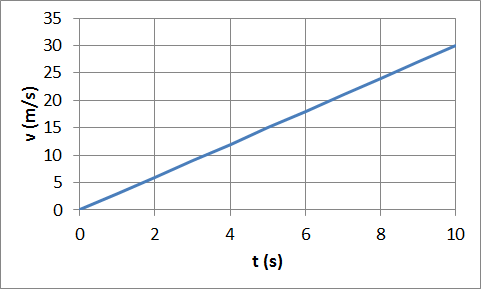
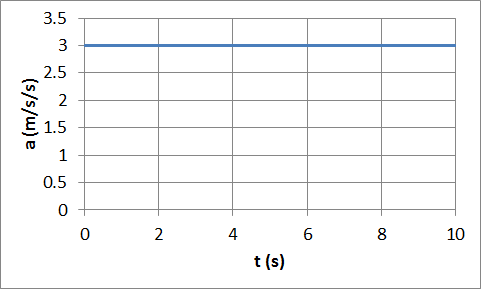
Let us assume at t = 0 a cart is leaving the origin with zero initial
velocity and constant acceleration of 3 m/s2
in the positive x-direction.
Then a = ∆v/∆t, vf
- vi = a(tf - ti), and since vi = ti
= 0 we have v(t) = a*t = (3 m/s2)*t.
The velocity (m/s) versus time (s) graph is a straight line with a slope of 3.
The acceleration
(m/s2) versus time (s) graph yields a
straight line (a = 3) with zero slope.


Let us consider one-dimensional motion in the x-direction.
Let us make
this explicit by using the subscript x.
The average acceleration equals the instantaneous acceleration.
From
ax = (vxf - vxi)/(tf - ti)
we obtain
ax(tf - ti) = (vxf - vxi),
or
vxf = vxi + ax∆t.
The velocity versus time graph is a straight line.
The average velocity in a
time interval ∆t therefore is just the sum of the final and the initial
velocities divided by 2,
vx(avg) = (vxf + vxi)/2.
The displacement is ∆x = vx(avg)∆t. We can rewrite this expression to obtain xf - xi = ½(vxf + vxi)∆t, or
xf - xi = vxi∆t + ½ax∆t2.
We can also express the velocity as a function of the displacement.
∆x = ½(vxf + vxi)∆t = ½ (vxf + vxi)(vxf
- vxi)/ax = (vxf2 - vxi2)/(2ax)
yields
vxf2 = vxi2 + 2ax(xf - xi).
The equations in red are the kinematic equations for motion in the x-direction with constant acceleration.
AI Study Tip:
Ask an AI to help you develop a strategy to pick the right tool (equation)
for a problem.
Example prompt: 'I am about to solve a constant acceleration problem.
I am given initial velocity vi, displacement ∆x, and time ∆t, but I
don't know the final velocity vf or acceleration a. Walk me
through the logic of which kinematic equation I should use first and why.
Don't solve it for me. Just help me pick the right "tool" from the
toolkit.'
Choose your coordinates so that xi = ti = 0. Then x = vit +
½at2.
This is the equation of a parabola. The
position versus time graph is a section of a parabola.
In the limit a = 0
it becomes a straight line.

 The speed versus time graph on the right represents the
motion of a car. Approximately how far did the car travel during the first
5 seconds?
The speed versus time graph on the right represents the
motion of a car. Approximately how far did the car travel during the first
5 seconds?
Solution:
Blood is accelerated from rest to v = 30.0 cm/s in a distance of 1.80 cm by
the left ventricle of the heart. Assume constant acceleration.
(a) Find the acceleration a.
(b) For how long does the blood accelerate?
(c) Is the answer reasonable when compared with the time for a heartbeat?
Solution:
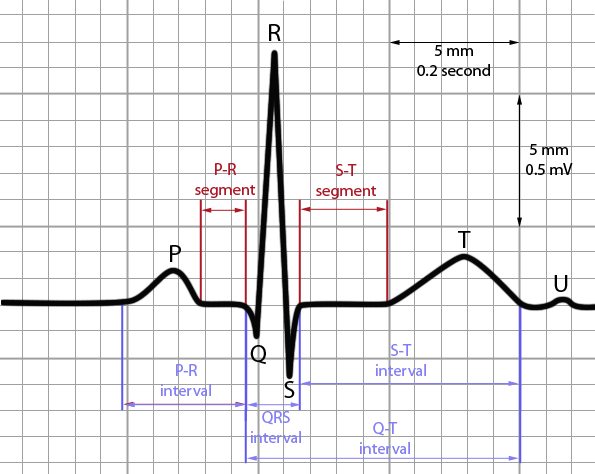
Systematic experiments on freely falling objects were carried out by Galileo Galilei (1564-1642). Near the surface of the earth all freely falling objects accelerate at approximately the same rate. This acceleration is denoted by g. Its direction is downwards, towards the center of the earth. Freely falling objects move with constant acceleration g = 9.8 m/s2 downward.
You drop a ball from a window on an upper floor of a building. It strikes the ground with speed v. You now repeat the drop, but you have a friend down on the street, who throws another ball upward with the same speed v. Your friend throws the ball upward at the same time you drop yours from the window. At some location the balls pass each other. Is this location at the halfway point between the window and the ground, above this point, or below this point?
Solution:
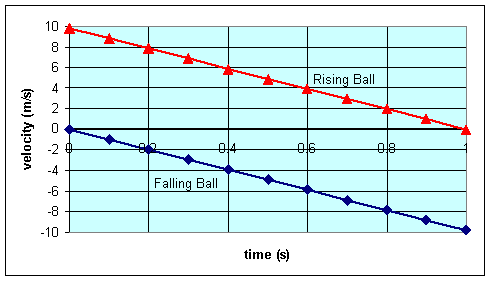
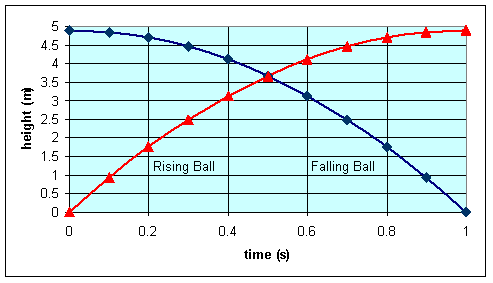
A stone is thrown directly upward with an initial speed of 4 m/s from a height of 20 m. After what time interval does the stone strike the ground?
Solution:
What is the speed of the stone in the previous problem when it hits the ground?
Solution:
Note: If the stone is thrown directly downward with an initial speed of 4 m/s, it hits the ground with the same speed, but at an earlier time.
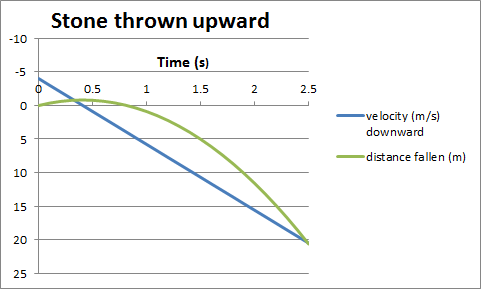
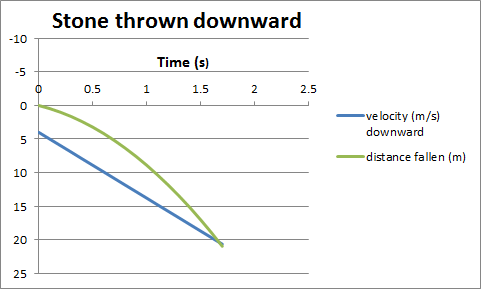
When the stone thrown upward returns to its original
position, its velocity is -vi.
The magnitude is that of the initial velocity, but the sign of the
velocity has changed.
The velocity is now in the downward direction.
From then on, the stone behaves exactly like a stone throw downward
with the same initial speed.
AI Study Tip:
Ask an AI to give you some short word problems.
Example prompt: 'Give me a short word problem about the acceleration of a
Cheetah leaping from rest to its top speed, or a frog jumping. Ask me to
calculate the acceleration and the distance covered. Once I provide my
answer, check my units (m/s2) and my significant figures.'